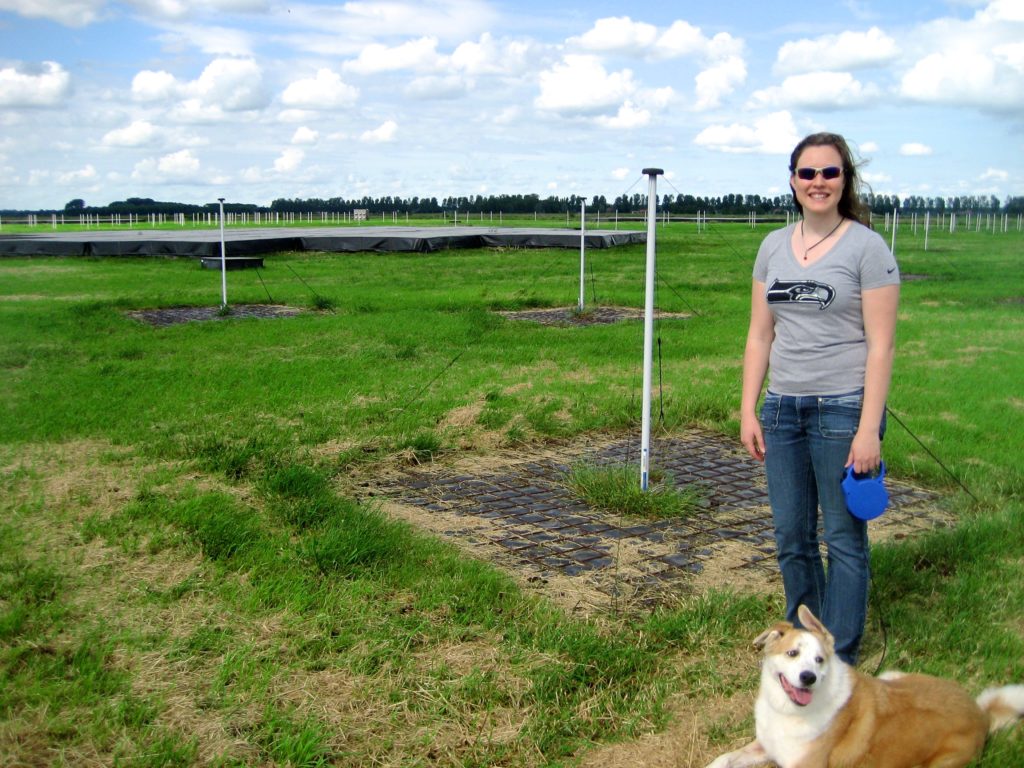When you’re creating a precise catalogue of measurements of our galaxy, you want to make sure people know! Perth-based astronomer Dr Charlotte Sobey is part of a team working on magnetic field mapping. She recently took part in the Fresh Science competition to help communicate her work and amplify her science.

Postdoctoral researcher and astronomer Charlotte Sobey hanging out in a telescope.
First, what’s the science?
Our galaxy’s magnetic field is thousands of times weaker than Earth’s. But it has great significance for tracing the paths of cosmic rays, star formation, and many other astrophysical processes. However, our current knowledge of the Milky Way’s 3-D structure is limited.
Charlotte and her colleagues used a large radio telescope in Europe called LOFAR (the Low-Frequency Array) to create the most precise measurements to date of our galaxy’s magnetic field in 3-D. We can’t see our whole galaxy from a single place on Earth. So, Charlotte is now completing the map in the Southern Hemisphere. To do this she’s using the Murchison Widefield Array (MWA) telescope which is led by Curtin University and located at our Murchison Radio-astronomy Observatory in Western Australia. The MWA combines the power of 2048 small antennas into one instrument.
The team chose pulsars (rapidly rotating neutron stars) as the ideal candidate to map the magnetic field. This is because they’re distributed throughout the Milky Way. And dark matter, which is the most dominant material in the galaxy, affects their radio-wave emissions.
How do you share your science story?
It’s important for Charlotte and other young researchers to be able to confidently and clearly communicate their work.
Charlotte recently participated in Fresh Science WA. It’s a national competition helping early career researchers develop their communication and outreach skills through a series of workshops.
“I applied to Fresh Science because it’s a great way to gain experience in presenting science stories in accessible ways for a variety of media, and to share my recently published results with the public,” Charlotte said.
“As a researcher in a publicly-funded organisation, I feel it’s important to communicate about recent science results with the community. I hope that these stories connect with people, perhaps inspiring them to learn more about STEM areas or even pursue a STEM-related career or hobby.”

Charlotte and her dog Kirby at the LOFAR telescope ‘Superterp’ stations near Exloo, Netherlands.
Charlotte and her dog Kirby at the LOFAR telescope ‘Superterp’ stations near Exloo, Netherlands.
Finding her voice
Across the two-day event, Charlotte attended media workshops, learned to pitch stories to journalists and write professional profiles. This training will help her tell her story to all types of media outlets.
“Talking with journalists helped demystify the news process, and answering their questions helped me to frame my science story. I also gained invaluable experience and confidence by doing practice interviews in a ‘safe space’ with three local journalists from television, radio and print.” Charlotte said.
“By talking to advisors from a commercialisation program and a public policy institute, I gained new insights into my work. This compelled me to expand my story to include the bigger-picture implications of my work, as well as talking about the future direction.”
Passing the pub test
After the pitching workshop, the ‘freshies’ headed down to the pub to complete the final exercise for Fresh Science 2019. Aptly named the pub test.
“I had to explain my recent work on stage in the time it took for a birthday sparkler to burn out! I’m usually nervous when I have to speak in front of people about my work – in front of colleagues, let alone the general public. But at the end of the two days I felt more prepared, practised, and confident. But still a little nervous!” Charlotte said.
“Sharing the experience with the other freshies and having the encouragement of the Science in Public staff also made it more social and enjoyable.”

Charlotte Sobey at Fresh Science 2019 during the pub test. Credit: Ross Swanborough.
What’s next for Charlotte?
“Doing Fresh Science has given me a greater understanding of how the media works, and to focus on being able to target my pitch to a specific audience to achieve a specific purpose. And with all the practicing I’m feeling much more confident and looking forward to sharing my story” Charlotte said.
LOFAR and MWA are stepping stones towards the low-frequency component of the Square Kilometre Array (SKA), which will be at the Murchison Radio-astronomy Observatory. SKA will be much larger and more sensitive than any radio telescope ever built.
“My work in the future will focus on building towards doing science with the SKA telescope, which is currently entering the final stages of the planning phase. One long-term goal for SKA science is to revolutionise our understanding of our galaxy, including producing a detailed map of our galaxy’s structure (which is difficult because we’re located inside it!), particularly its magnetic field.”


9th December 2019 at 11:58 am
Great stuff Charlotte. If we’d been giving scientists this kind of training 50 yrs ago – when I was at uni – then maybe climate denial wouldn’t be happening.
If you ever want a 60 minute speaking gig in Noosa pls contact me. There’s a fire-ban so we wouldn’t time you with sparklers.